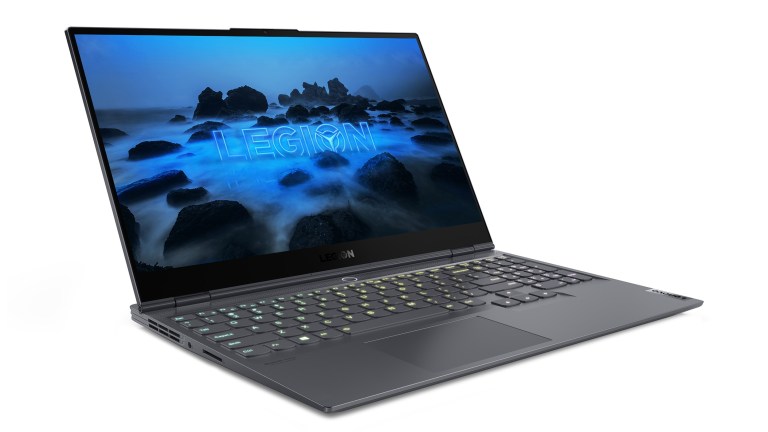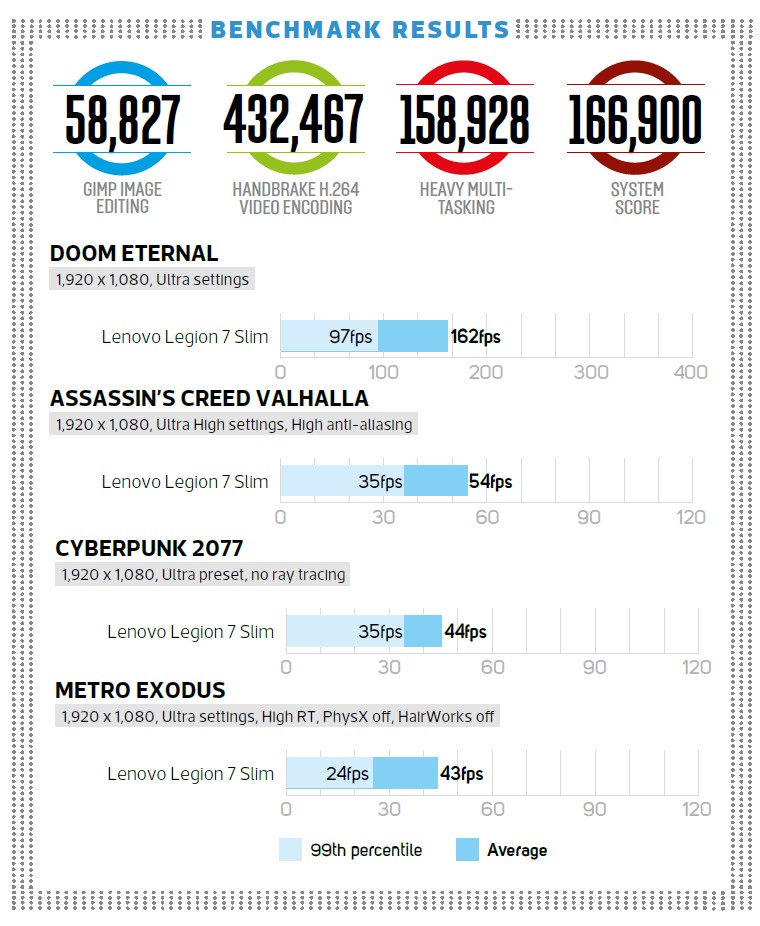The Lenovo Legion Slim 7 Is a Solid Replacement for the Traditional Gaming Laptop
It’s not the fastest machine, but it’s ideal if you want a lightweight alternative to conventional gaming laptops.

This review comes courtesy of: 
Subscribe to the magazine here.
As its name suggests, the Lenovo Legion Slim 7 ($1,199/£1,399) is designed to provide a leaner and lighter experience than most gaming laptops, and it immediately impresses with an 19mm-thick frame and a weight of 4.1 pounds. That’s 8mm slimmer and more than a pound lighter than Lenovo’s own Legion 5 Pro, which is our current favorite budget gaming laptop.
Lenovo’s lithe laptop maintains good build quality despite its cut-back dimensions. It’s made of smooth black aluminium, it looks unfussy and discreet, and there’s hardly any give in the screen or panels. That makes it easy to put this lightweight laptop in a bag without fear of breakages, and it will occupy less space than most 15.6in rivals.
The Legion has good features, despite its slimline body. There’s an SD card reader on the left-hand side, and the rear has two USB 3.2 Gen 2 ports. The right-hand edge also has two USB 3.2 Gen 2 Type-C ports that handle DisplayPort and 100W of power delivery.
Meanwhile, the power button includes a fingerprint sensor, and the speakers are reasonable – punchy, loud, and good enough for everyday use, despite a slightly muddy mid-range. The design isn’t perfect – those USB Type-C ports could obstruct right-handed mouse users, the webcam has a privacy shutter but no Windows Hello support, and there’s no HDMI output. There’s also no Ethernet, although you do at least get dual-band Wi-Fi 6 and Bluetooth 5.1 support.
There’s lots to like about the keyboard though. It has bright, bold per-key RGB backlighting, a number pad, and loads of secondary functions. The keys are fast and comfortable to use, although they’re softer and shallower than the keys on most fatter laptops.
Shallow buttons are no surprise on a slim laptop, though, and neither are component compromises. The Legion’s RTX 3060 has an entry-level 60W TDP and just 6GB of memory, while the Ryzen 7 5800H CPU peaks at 45W, so both parts run a long way short of their maximum potential. The Lenovo also has 16GB of dual-channel memory and a 512GB SSD with decent read and write speeds of 3,599MB/sec and 2,278MB/sec, although a 1TB drive would be better for accommodating large game installs.
There’s a decent screen too. The 1080p panel has a 165Hz refresh rate and NVIDIA G-Sync support. Its contrast ratio of 1,163:1 is punchy and vibrant, and the delta E of 1.8 means colors are accurate. The screen displayed 97.2 percent of the sRGB color gamut at a temperature of 6,947K, and it’s bright enough for indoor and outdoor use. It’s ideal for mainstream games, even if it doesn’t have the extended gamut demanded by creatives.
This specification is good considering this machine’s dimensions, but going for a slimmer chassis does result in compromises. Comparatively, Lenovo’s $1,359/£1,499 Legion 5 Pro may be thick and heavy, but it has an RTX 3070 that runs at 140W, a 2,560 x 1,600 display and more connection options.
PERFORMANCE
The Legion’s modest RTX 3060 6GB GPU returned 99th percentile results of 35fps in Assassin’s Creed Valhalla and Cyberpunk 2077. Those results are playable, but you’ll need to drop the settings to hit 60fps averages in these sorts of demanding titles.
You’ll get underwhelming results with ray tracing too, even with DLSS enabled – activating both options in Cyberpunk 2077 dropped the 99th percentile result by 10fps, and enabling DLSS on Metro Exodus didn’t make that game playable with ray tracing enabled either. With only 6GB of memory, the RTX 3060 can’t run Doom Eternal at our usual Ultra Nightmare settings either, but its average of 162fps at Ultra settings shows the potential for playing undemanding titles in sync with the 165Hz display.
Not surprisingly, there’s a clear gulf between this laptop and conventional machines. The Lenovo Legion 5 Pro and its RTX 3070 was 10fps faster in Cyberpunk 2077 and further ahead in other games. You’ll also get a little more pace from RTX 3060 portables with more generous power limits.
Meanwhile, the 45W 5800H scored 58,827 in our image editing test and 432,467 in the Handbrake benchmark. Those are decent scores, and they mean that this laptop can tackle mainstream photo editing, content creation, and multi-tasking. In the heftier Legion 5 Pro, though, the same CPU ran without power restrictions, and it hit scores of 66,123 and 531,406 in the image editing and Handbrake tests respectively.

These results were recorded with the Lenovo’s default cooling mode. With this setting selected, the Legion was quiet and cool during games and work tests. That’s good, but clock speeds suffered – the GPU peaked at just 1450MHz, and the processor’s respective single and multi-core frequencies of 4.1GHz and 3.2GHz fall short of its top clocks.
Activating Performance mode saw the GPU’s TDP increase to 90W and its clock speeds hover around 1785MHz. This added 12fps to the Doom Eternal 99th percentile result and 3fps to its Assassin’s Creed Valhalla average. That’s a reasonable boost, but you’ll have to suffer with noticeable fan noise and an uncomfortably hot underside to get that extra performance.
Performance mode had less impact on application benchmarks, with no change to single-core speeds and a revised multi-threaded clock of 3.7GHz. That improved the machine’s overall system score to 203,070 and fan noise remained modest, but it still can’t catch conventional laptops.
The Lenovo’s 71Wh battery isn’t particularly big either, and the Legion Slim 7 lasted for one hour, 13 minutes during gameplay. If you don’t change the settings, then the Legion lasts for three hours during work tasks. As with the Legion 5 Pro, though, this rig has a hybrid mode that uses the CPU’s integrated graphics. With that option deployed, and the screen brightness reduced by 50 percent, the Lenovo lasted for six hours, 25 minutes in office tasks. If you’re careful, you’ll get most of the way through a working day on the move with this machine, and you can’t say that about most gaming laptops.
VERDICT
The Legion Slim 7 isn’t the quickest gaming laptop, but it’s fast enough for mainstream games if you’re happy to drop the settings a bit, and it excels elsewhere. It’s slimmer and lighter than other 15.6in gaming machines, and it has a good keyboard, a vibrant display, and better battery life than most rivals. The lack of graphical horsepower and the better screen and connection options on the Legion 5 Pro mean it’s still our affordable favorite, but the Slim 7 is a good alternative if your top priority is getting a svelte machine.
PROS
+ Slim, light and sturdy
+ Mainstream gaming and work ability
+ High-quality 1080p display
+ Decent battery life
CONS
– Relatively weak performance
– Some missing connection options
– Better screens available elsewhere
SPECS
CPU
3.2GHz AMD Ryzen 7 5800H
Memory
16GB 3200MHz DDR4
Graphics
Nvidia GeForce RTX 3060 6GB
Screen
15.6in 1,920 x 1,080 IPS 165Hz G-Sync
Storage
512GB SK Hynix PC711 M.2 SSD
Networking
Dual-band 802.11ax Wi-Fi, Bluetooth 5
Weight
4.1 lbs
Ports
2 x USB 3.2 Gen 2, 2 x USB 3.2 Gen 2 Type-C/DisplayPort, 1 x audio, 1 x SD card reader
Dimensions (mm)
356 x 252 x 19 (W x D x H)
Operating system
Windows 10 Home 64-bit
Warranty
One year parts and labour return to base